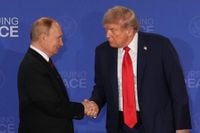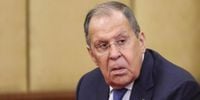The diplomatic chessboard between Washington and Moscow has shifted dramatically in recent weeks, as high-level talks, missile tests, and public statements reveal both progress and peril in the quest to end the war in Ukraine. The latest developments center on Russian President Vladimir Putin’s apparent willingness to accept a U.S.-proposed plan for peace, even as new tensions erupt over Russia’s nuclear arsenal and the role of European allies in shaping American policy.
According to Russian Foreign Minister Sergey Lavrov, the turning point came at the 2025 Russia–United States Summit, held in October at Joint Base Elmendorf-Richardson in Anchorage, Alaska. This was the first in-person meeting between Putin and former U.S. President Donald Trump since 2019, and the agenda was dominated by efforts to halt the conflict that began with Russia’s full-scale invasion of Ukraine in February 2022. Lavrov, speaking to Hungary’s Ultrahang YouTube channel, explained that the groundwork for the summit had been laid when Trump’s special envoy, Steve Witkoff, brought Washington’s peace proposals to Moscow for careful review. During the summit, Putin meticulously examined each element of the U.S. plan, confirming details with Witkoff before expressing Russia’s readiness to move forward.
"Everything was confirmed. After that, Putin stated that the Kremlin is ready to accept their concept and move forward in practical terms on the proposed basis," Lavrov told Ultrahang. The U.S. plan, as outlined by Trump in a September 29 White House address, calls for a 30-day ceasefire, direct negotiations between Russia and Ukraine, U.S. guarantees for a demilitarized buffer zone in Donbas and Crimea, and sanctions relief tied to verifiable de-escalation. The approach was seen as a bold gambit, with Trump campaigning on a promise to swiftly end the war if returned to office.
Yet, beneath the surface, fault lines have emerged. On October 26, Lavrov criticized what he described as a "radical" change in the U.S. administration’s approach, claiming Washington had shifted from supporting a stable, long-term peace to demanding an immediate ceasefire—a stance Lavrov attributed to pressure from European allies and Ukrainian President Volodymyr Zelenskyy. "Now [representatives of the U.S. administration] are only talking about an immediate ceasefire, and then history will judge. This is a radical change. But it also means that Europeans are not sleeping or eating and are trying to twist the arms of this administration," Lavrov asserted in the same interview.
Lavrov’s comments highlight a fundamental rift: while Trump’s plan envisions a halt to hostilities and negotiations, the Kremlin remains unwilling to agree to any cessation of fighting unless it results in Ukraine’s surrender. The Institute for the Study of War, in an October 22 analysis, noted this divergence, observing that Moscow’s war aims are at odds with Washington’s expectations for an immediate ceasefire. Lavrov, for his part, accused the U.S. of succumbing to "tremendous, incredible pressure" from Europe and Kyiv, both of which, he claimed, are determined to block any form of cooperation with Russia and to increase the flow of Western weapons to Ukraine.
The diplomatic drama unfolded against a backdrop of renewed military escalation. On October 27, just days after the Anchorage summit, Russia conducted a successful test of its nuclear-capable Burevestnik cruise missile—a ground-launched, low-flying weapon powered by nuclear energy and designed to carry a nuclear warhead. President Putin himself announced the test, which, according to Reuters, demonstrated the missile’s theoretically unlimited range and ability to evade existing missile defense systems. NATO refers to the weapon as the SSC-X-9 Skyfall, and Putin first unveiled the project in 2018, touting its strategic significance.
The missile test drew immediate condemnation from Trump, who spoke to reporters aboard Air Force One. "Russia’s recent weapons test was not appropriate," Trump declared, as quoted by iNews and other international outlets. He went further, urging Putin to "stop the war in Ukraine" and focus on diplomacy rather than military brinkmanship. Trump’s frustration was palpable. Having repeatedly tried to broker peace—including the much-publicized Alaska summit—he found himself watching as Russia intensified its attacks on Ukraine in the aftermath, undermining hopes for a lasting ceasefire.
In response to the escalating conflict and Moscow’s nuclear posturing, the U.S. announced a new round of sanctions targeting Russian oil giants Rosneft and Lukoil. These measures, part of a broader pressure campaign, aim to squeeze the Kremlin’s war chest and signal Washington’s resolve. Trump, for his part, has drawn a line in the sand, stating that he will not meet with Putin again until a peace deal is in place. The diplomatic standoff underscores the high stakes and the fragility of any potential breakthrough.
The evolving U.S. position has not gone unnoticed in Europe, where leaders remain deeply invested in Ukraine’s fate. Lavrov’s assertion that "European hawks" and Zelenskyy are shaping American policy reflects Moscow’s longstanding suspicion of Western unity and its desire to drive a wedge between Washington and its allies. Yet, the reality is more complex. Many European governments, scarred by the devastation of the ongoing war and the threat of further Russian aggression, have lobbied Washington to push for an immediate ceasefire and to maintain strong support for Kyiv. Their influence is evident in the Biden and Trump administrations’ evolving strategies, as well as in the robust flow of military aid to Ukraine.
Meanwhile, Ukraine’s leadership remains wary of any settlement that could cement Russian gains or leave the country vulnerable to future attacks. President Zelenskyy has consistently insisted that any peace deal must respect Ukraine’s territorial integrity and sovereignty—a position backed by much of the international community, but one that Moscow has repeatedly rejected. The gulf between these positions has complicated efforts to find common ground, even as the human cost of the war continues to mount.
For ordinary Ukrainians, the latest diplomatic maneuvers offer both hope and anxiety. The prospect of a U.S.-brokered ceasefire, with international guarantees and the possibility of sanctions relief, could open the door to a negotiated settlement. But the specter of renewed violence—and the risk of nuclear escalation—looms large. As Lavrov’s remarks and Russia’s missile test make clear, the road to peace remains fraught with obstacles.
World leaders and observers are watching closely as the situation evolves. The coming weeks will test the resolve of diplomats and the willingness of all parties to compromise. Whether Trump’s plan can deliver a lasting peace, or whether the rift between Moscow and Washington will deepen, remains an open question. But for now, the world holds its breath, hoping that words will finally triumph over weapons.

